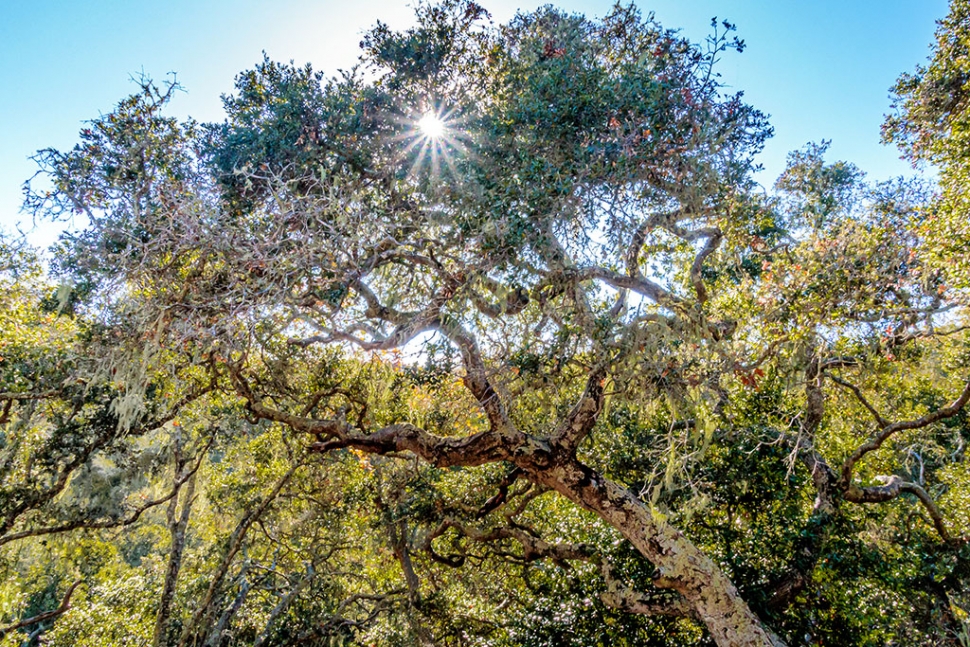|
Focus on Photography
 Photo of the Week: "An oak, some lichen, Spanish moss and a sunstar. Ah!" by Bob Crum. Photo data: Canon 7DMKII camera with Tamron 16-300mm lens @16mm, no filters. Exposure; ISO 1,000, aperture f/22, shutter speed 1/100 second. By Bob Crum — Tuesday, December 24th, 2019
It's all legal
 Bob Crum I concluded my previous column with this question: Did I post-process the photo of the week? Silly question, right? Of course I did. I'm resubmitting the photo again as a reference for the following discussion. (See the photo in color at fillmoregazette.com) Even though the camera's histogram revealed proper exposure, the camera did not correctly capture all of the elements of the photo. Here's why and the corrections I applied to improve it. A camera/lens combo cannot see as our human eyes see. A filter on the sensor generates RGB pixels. But seldom does the filter/sensor combination capture the Kelvin of the light (color) accurately. The sensor sends image data to the recording medium. Unless the camera is ultra-high-tech, the dynamic range of the light will exceed the camera's ability to record it entirely. The camera's picture-style algorithms also affect the image produced — multiple reasons why no photo straight out of the camera is as good as it could be. I like to evaluate a scene before making a photo. Taking a moment to study the scene also helps the mental recall during post-processing. The camera settings for the reference photo were: 'Auto' ISO and shutter speed 1/100 second. I closed aperture to f/22 to create the Sunstar effect. I know that closing the aperture f/22 means underexposing the image. (Remember the exposure triangle?) To compensate, I could slow the shutter speed further or manually increase the ISO. However, shooting hand-held, I prefer not to go slower than 1/100th second to minimize handshake (blur). The camera automatically raised the ISO to 1,000, somewhat high but passable. Nevertheless, the photo lacks the dynamic range of light at the scene. Capturing in RAW mode will permit me to make appropriate adjustments during post-processing. I made several photos in portrait and landscape mode. On the monitor back home, I was not surprised to see some anticipated issues. Landscape orientation the obvious choice because I wanted to include the Spanish moss on the horizontal branches on the left. (See the hanging moss?) In the original RAW file, the moss color is wrong. Also, the bright sun flummoxed the camera's exposure meter, discombobulating the overall exposure. Ugh! And the lichen on the tree lacked the texture that I saw in real-time. Adobe Lightroom (LR) to the rescue! First, quaffed a strawberry margarita, you know, to finesse creativity. Recall that a RAW file is not yet a photo, just data LR (or any other RAW converter) interprets and forms an image. I exposed the photo for the bright sun, which I knew would underexpose the lower half of the image. Had I exposed for the shadows, the top half of the image would be overexposed. I easily brought back details in the shadows with the LR gradient filter which allows for adjustments of exposure, contrast, highlights, clarity, & saturation in the defined area. I next tweaked clarity and texture. In the color panel, I decreased blue luminosity slightly to restore sky color. I increased overall contrast slightly. Now the photo is beginning to look as I saw the scene in real time. The last LR step was to apply lens correction. Depending on lens quality and the settings, lenses are notorious for producing various kinds of distortion, chromatic aberration, and perspective issues. LR usually fixes most lens issues, if they exist. This creative process took about three minutes and, yes, I'm legally allowed to have such fun! But I was not yet done! I exported the image, in the tiff format, to Photoshop Elements 2020 (PSE), with NIK plugins. In the tiff format, it's now a digital photo, not just data. To be continued... Wishing you the Merriest Christmas and a Happy, Healthy New Year! Send questions, suggestions or comments to: focusonphotography@earthlink.net |
